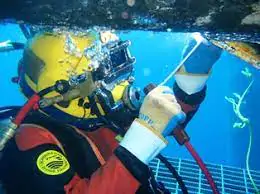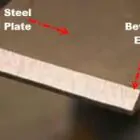Deep underwater on Earth, things can be just as strange as in space. Bridges, oil platforms, and other structures reach into and over these areas. To build and maintain these structures, skilled workers are needed. Above the surface, all it takes to weld, cut, and put together these structures is training and skill. To do these same jobs underwater, you need a whole new set of skills, knowledge, and tools. Welcom to the world of commercial diving and, more specifically, underwater welding.
People often say that underwater welding is one of the most dangerous jobs on earth. This is because the environment, the tools, and even the welding process itself can all be dangerous. What makes a good underwater welder? “Grit,” says fifteen-year veteran diver Kirk Hooker. “Toughness and endurance.” Someone might become a welder-diver because they like to try new things, but they will need patience and determination to be successful.
Wet- vs Dry-welding?
There are two ways to weld underwater. Wet welding, which is the focus of this article, and dry or hyperbaric welding. Hyperbaric welding is done underwater, but the weld is kept safe by a dry environment. This can be small enough to just cover the area being welded, or it can be big enough to hold a whole team of welders. Welding dry underwater comes with its own problems, such as high costs. The biggest advantage over wet welding is that it looks like surface welding. This means that you can use more than one process to make a stronger weld.
How hard it is to weld underwater?
Shielded metal arc welding (SMAW) and electrodes with special coatings are used for wet welding. Any welder knows that to make a good weld, you have to keep a close eye on the arc and the weld puddle. Wet welding is hard because it is hard to see what you are doing. There isn’t much light and things are floating around in the water. As with a regular welding hood, the view inside the helmet is limited, but welder-divers need to be more aware of their surroundings than surface welders. People’s breath and the welding process are always making air bubbles that block the view. Even if the diver can get into a good spot where the bubbles don’t get in their eyes, it’s still hard to see the arc because the water keeps soaking up the weld puddle. It’s important to keep the arc gap small, and there isn’t much puddle to watch. Keeping a weld fluid is hard, and making good-looking welds underwater is much harder than above the surface.
Pressure, flow, and visibility are all affected
Divers sometimes have a harder time seeing in man-made underwater environments than in natural bodies of water. Commercial divers do repairs and maintenance at places like nuclear power plants and facilities that treat wastewater. For safety, some of these places to dive need haz-mat suits. The water is so thick and dark that divers have to work blind. When they can’t see, they work by touch and sound.
Welding under water is hard because you can’t see very well.
The flow of water is also a problem. Divers can be pushed and pulled by water currents as they try to do their jobs. Weight belts and buoyancy aids can help, but the water may or may not be moving, depending on where you are. Welder-divers need to know their work environment and how deep the site is so they can make plans. During deep dives, the pressure is very high. Differential pressure is one of the most dangerous things that can happen to divers. This happens when two different levels of water meet, like at a dam or another bottleneck. The higher elevation adds to the force that moves water from one place to another, often through a small opening. If the diver gets stuck in this flow, the pressure on his or her body against the opening can cause serious injuries or even death.
How it differs from welding on land?
Everything underwater takes longer. On the surface, a simple T-joint can be put together in less than a minute. Putting on dive gear, on the other hand, takes about ten minutes. Depending on the dive, the average set of gear weighs more than 100 pounds. Divers don’t work alone, so welder-divers have to check their communication system in addition to welding and preparing the site. To get the diver ready and weld in a safe way, it takes a team. Even getting to the weld site takes time, whether you go straight down or into an underwater tunnel that goes hundreds of feet down. When working underwater, there is no such thing as a “quick weld.”
For safety when welding under water, you should wear clothes that protect you from electricity and the temperature of the water. Electricity goes the quickest way from one place to another, even if that means going right through your body. It is very important to know where the welding ground line is in relation to the weld site. If you are between them, you could get an electric shock.
The welding/diving helmet is a lot heavier than a regular welding helmet. It lets the diver breathe, talk, and often has a light on it to help them see. Welding hoods can cost up to $2,500, but new diver helmets can start at that price and go up to $10,000 or more. When you factor in the costs of wet and dry suits, power supplies, and other supplies, it’s easy to see why welder-divers don’t usually work for themselves.





